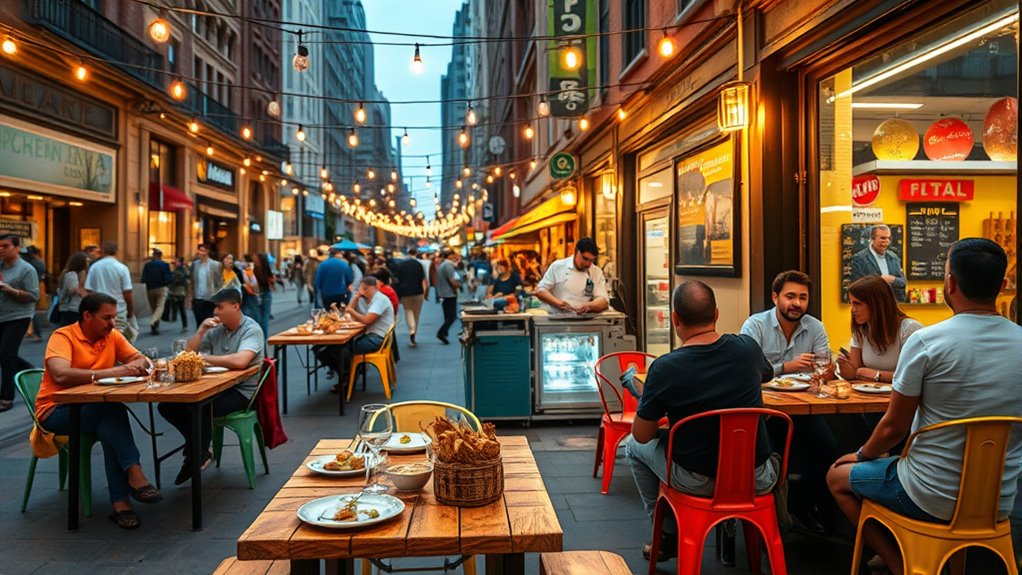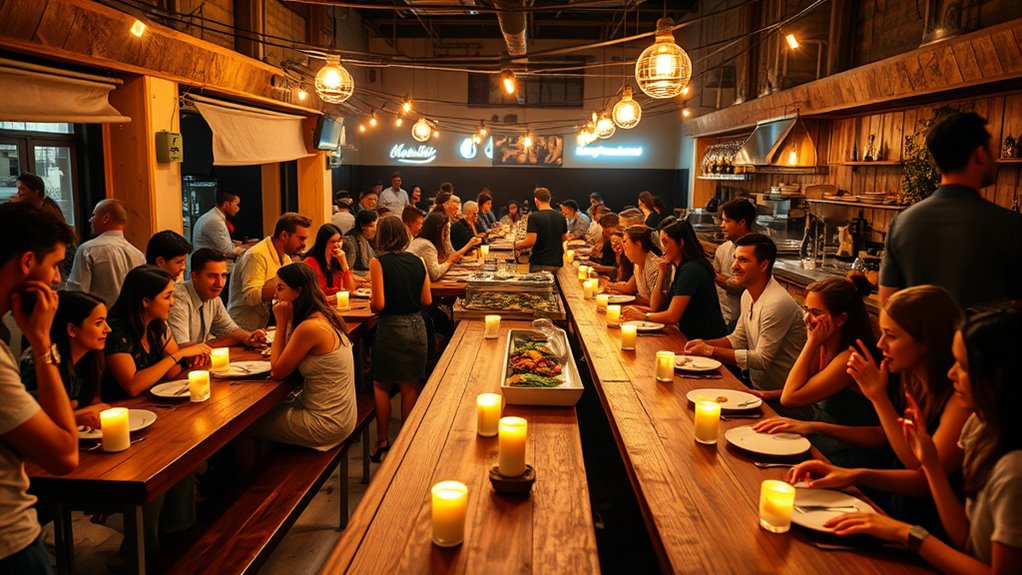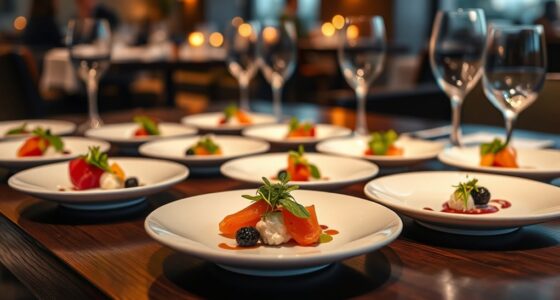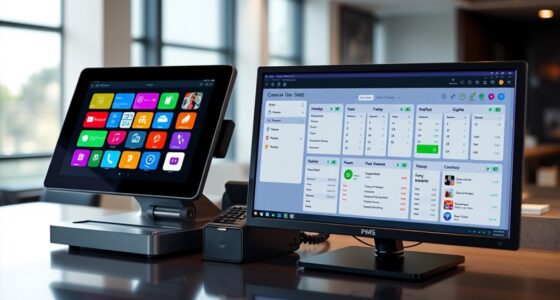A pop-up restaurant is a temporary dining spot that appears in unconventional locations like warehouses, galleries, or storefronts. It often offers exclusive and innovative menus for a limited time, creating excitement and a sense of adventure. These experiences focus on creativity, collaboration among chefs, and seasonal ingredients, making each visit special and memorable. If you’re curious about how these unique venues operate and what makes them so popular, there’s more to discover ahead.
Key Takeaways
- A pop-up restaurant is a temporary culinary venue that operates in unconventional spaces for a limited time.
- It creates buzz through its fleeting presence, offering exclusive and memorable dining experiences.
- Pop-ups often feature collaborations between chefs, showcasing innovative menus and unique concepts.
- They emphasize seasonal ingredients, sustainability, and quick adaptation to trends.
- These restaurants provide intimate, curated environments that encourage exploration and a sense of adventure for diners.

Have you ever wondered how dining experiences can be both temporary and extraordinary? That’s the essence of a pop-up restaurant. Unlike traditional eateries with fixed locations and permanent menus, pop-ups are fleeting culinary ventures that appear suddenly, serve a specific purpose, and then disappear. They create buzz and excitement because you never know exactly when or where they’ll pop up next. These restaurants often operate in unconventional spaces—vacant warehouses, art galleries, or even storefronts—transforming them into intimate dining rooms for a limited time. Their impermanence makes each visit feel special, like being part of a secret culinary adventure.
One of the key elements that set pop-up restaurants apart is their focus on innovation and collaboration. Many pop-ups feature chef collaborations, where renowned or emerging chefs team up to craft unique menus that aren’t available anywhere else. These collaborations bring fresh ideas and diverse culinary influences together, appealing to adventurous diners enthusiastic to explore new flavors. Since pop-ups are temporary, chefs often use them as a platform to experiment with concepts and ingredients they might not pursue in their regular restaurants. This creates an environment of creativity and surprise that keeps diners coming back for more.
Seasonal menus are another hallmark of pop-up dining. They reflect the freshest ingredients available at a particular time of year, emphasizing sustainability and local sourcing. By focusing on seasonal ingredients, pop-ups can offer dishes that are vibrant, flavorful, and unique to that moment. This emphasis on seasonality also allows chefs to adapt their menus quickly, responding to what’s in abundance or what’s trending. The limited duration of pop-ups means the menu is often dynamic, changing with the seasons or even week to week, creating a sense of urgency and exclusivity. You get to experience a culinary journey that’s constantly evolving, tied closely to the natural cycle of ingredients.
Ultimately, a pop-up restaurant is about more than just food; it’s about creating a memorable, one-of-a-kind experience. It’s an opportunity for chefs to push boundaries, collaborate with others, and showcase seasonal ingredients in innovative ways. For you, as a diner, it’s a chance to enjoy a curated, intimate meal that feels like a special event. The temporary nature of pop-ups invites you to seize the moment, knowing that this experience might never be replicated exactly the same way again. That’s what makes pop-up restaurants so exciting—you get to be part of something fleeting, yet profoundly memorable.
Frequently Asked Questions
How Long Does a Pop-Up Restaurant Typically Operate?
A pop-up restaurant typically operates for a temporary duration of a few days to several weeks, depending on its concept and goals. The operational timeframe is usually short, allowing you to test new ideas, create buzz, or serve a niche market. You should plan for this limited window, focusing on efficient setup and marketing to maximize impact during its brief existence.
What Are the Common Locations for Pop-Up Restaurants?
Think of pop-up restaurants as explorers seeking new territories; they often land in urban spaces like trendy neighborhoods or bustling streets. You’ll find them in vacant storefronts, transforming empty shops into lively dining scenes. These locations are chosen for their foot traffic and visibility, making each pop-up a unique adventure. Whether in a vacant storefront or a pop-up park, they thrive where urban energy invites curious diners to discover something fresh and exciting.
Do Pop-Up Restaurants Require Special Permits or Licenses?
Yes, pop-up restaurants typically require permits and licenses. You need to check local regulations to understand the permits required for food service, health and safety, and liquor if applicable. The licensing process can involve submitting applications, passing inspections, and paying fees. It is crucial to complete these steps beforehand to avoid legal issues and ensure your pop-up operates smoothly and complies with all health and safety standards.
How Do Chefs Choose the Concept for Their Pop-Up?
You choose a concept for your pop-up by considering your passions and target audience. For example, a chef might focus on menu innovation, offering a unique fusion dish, or develop branding strategies to stand out in a crowded market. Think about what excites you and what will attract customers. Your concept should reflect your culinary style and create buzz, making your pop-up memorable and engaging.
Can Customers Make Reservations at Pop-Up Restaurants?
You can often make reservations at pop-up restaurants, but it depends on the reservation policies they set. Some pop-ups accept bookings in advance to enhance your customer experience, while others operate on a first-come, first-served basis. To secure a spot, check their website or social media for reservation details. Planning ahead and understanding their policies guarantees you enjoy a seamless experience at these unique dining events.
Conclusion
So, now you know what a pop-up restaurant is, but the real question is—what’s next? Will you experience one firsthand, or even host your own? As these culinary adventures grow more popular, the possibilities are endless. One thing’s certain: the world of pop-up restaurants is full of surprises waiting to be uncovered. Are you ready to step into this exciting trend and see what culinary magic awaits? The next chapter is yours to write.









